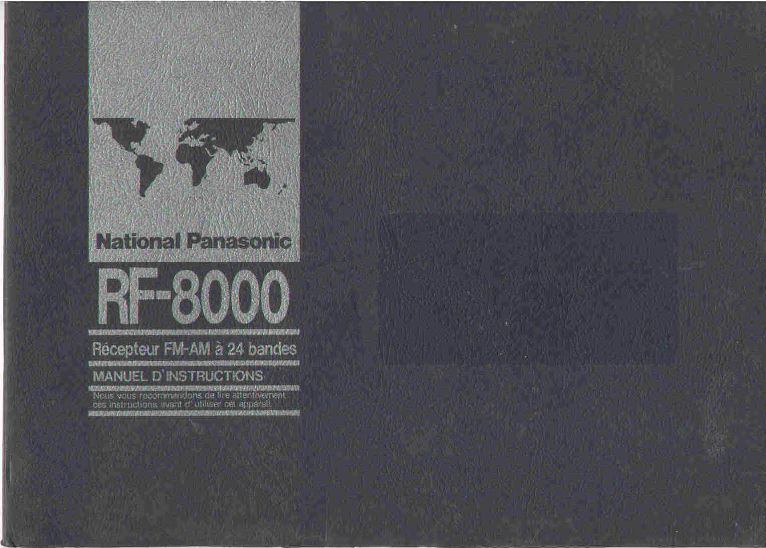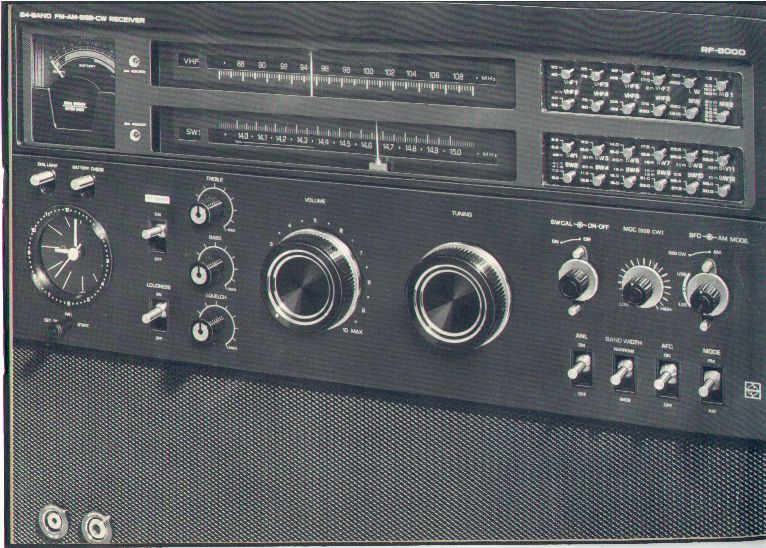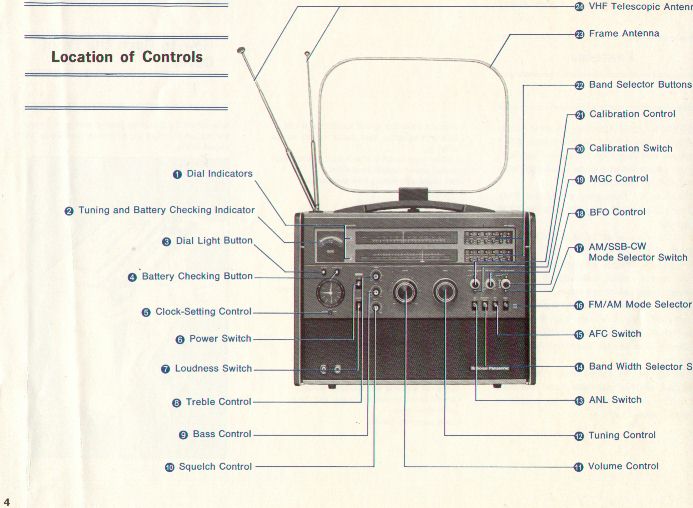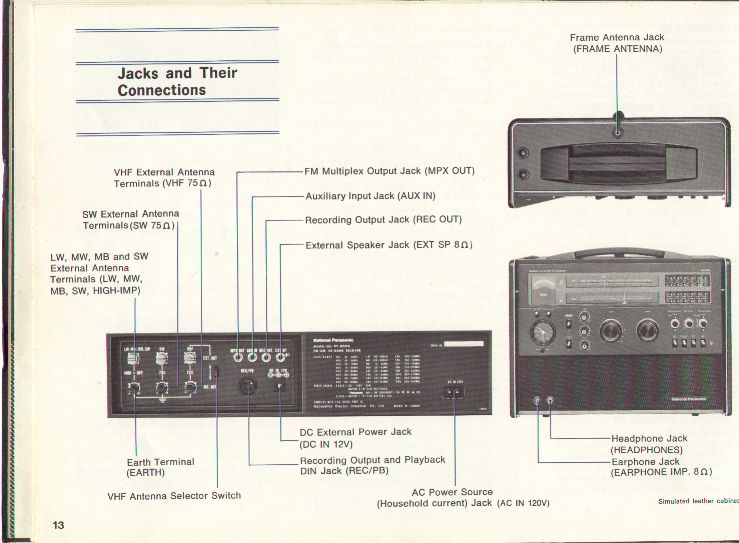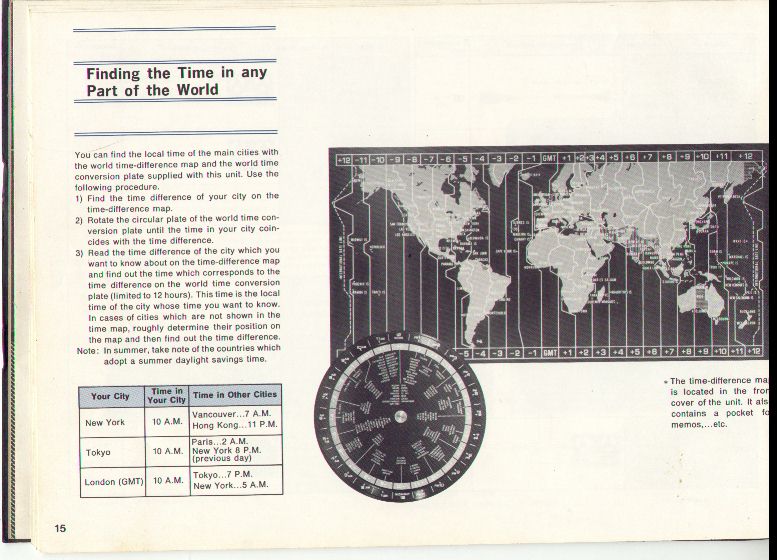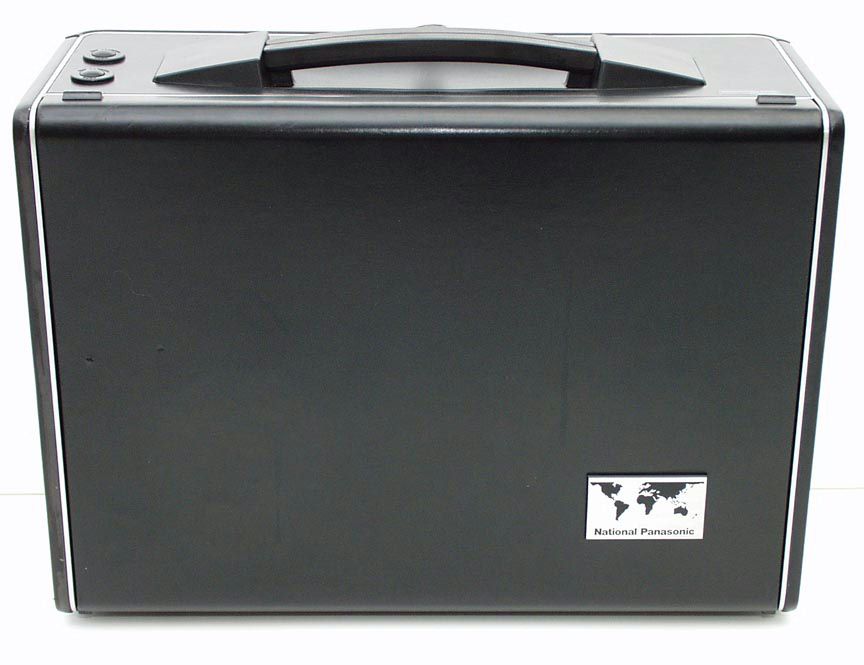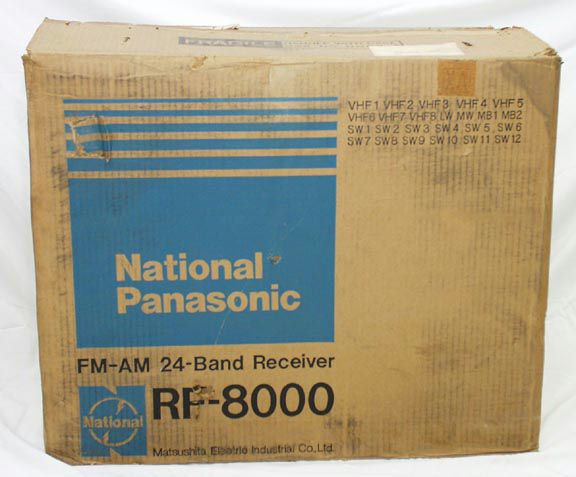National Panasonic RF-8000
24-Band Pure Analog Radio
Broadcast Coverage from 150 KHz to 230 MHz
"The radio that costs you everything, but brings you the world!"
FastCounter - Hits Since May 9th, 2001
General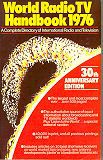 The National Panasonic RF-8000 was introduced to the public in the 1976 World Radio TV Handbook, a specialized publication for shortwave and other broadcast enthusiasts. The suggested retail price for the radio was $3,400.00 (in 1976 US dollars.) I first saw the radio on top of a counter at Burdine's, an upscale department store located in Fort Lauderdale, at the Broward Mall in Florida. It stopped me dead in my tracks - I had never seen anything remotely like it.
The National Panasonic RF-8000 was introduced to the public in the 1976 World Radio TV Handbook, a specialized publication for shortwave and other broadcast enthusiasts. The suggested retail price for the radio was $3,400.00 (in 1976 US dollars.) I first saw the radio on top of a counter at Burdine's, an upscale department store located in Fort Lauderdale, at the Broward Mall in Florida. It stopped me dead in my tracks - I had never seen anything remotely like it.
Aside from the stunning price, this radio was unique in many ways. With the front of the case closed, the first thing you would notice is its size; the radio stands 15 1/2 inches tall, extends 9 inches in depth, and spans 20 inches in width. To put it bluntly, it is huge. The second thing you might notice, if you picked it up (or tried to!) is that it is extremely heavy - 47.6 pounds without the 8 "D" batteries required for what Panasonic optimistically calls "portable" operation. This radio is not exactly something you'd take to the beach, swinging jauntily from one hand. Once you open the front cover, the next thing you'd almost certainly pick up on is that it doesn't seem - well, complicated enough for a radio of its price, weight and dimensions. What is going on here? To answer that, we have to delve into how the radio is operated, and what that meant in terms of 1976 technology.
Spectrum CoverageThe RF-8000 covers twenty-four radio bands, broken into two banks of twelve each. These are:
Bank One:
Bank Two:
If you press one of the buttons in the bottom group of 12 buttons, a band from group two is selected, and the correct dial scale rotates into position behind the bottom bezel.
Only one band may be received at one time; the active set is indicated by a small red LED indicator immediately to the left of the each bezel. This "scale-switching" technology is the basis behind how the front panel of the radio can look so uncluttered, yet manage so many different reception bands. More modern receivers often treat the entire spectrum a radio covers as one continuous band, and so generally avoid the entire issue of bands; further, digital displays simply read out the precise received frequency and eliminate the need for a dial scale at all. In 1976, however, those technologies were just being born, and the RF-8000 was an amazing feat of shortwave band management technology.
The breaking up of the spectrum into shorter segments offered the ability to spread the distance between channels, or more practically speaking, broadcast stations, out as compared to most designs. This makes the RF-8000 a very easy radio to work with for the user.
Another issue that most pure analog portables did not address very well was dial accuracy. On the shortwave bands, the RF-8000 offers a crystal calibration (beat tone) setting that places audible "markers" every 500 KHz.
Other FeaturesThe RF-8000 boasts a large and useful signal strength meter. It is not calibrated in S-Units, just from 0 to 10, but as S-Units vary in meaning from radio to radio, I don't consider that much of a drawback. The large and sensitive meter allows you to adjust the antennas for the absolute best position without any doubt. I wish more radios had as good a metering system.The dial lighting illuminates the S-meter as well as the two band scales; lighting is on all the time when the RF-8000 is connected to the AC mains, and may be turned on using a momentary switch when operating from its internal battery supply. This means that you're well advised to operate that RF-8000 on batteries; otherwise, the lamps will burn all the time, and they will burn out sooner, rather than later. Replacing the dial lamps is a many hour job, even for someone who knows the radio quite well - longer for others. A very desirable mod for this radio would be to (a) route the dial lamps through a switch whether on AC or DC power, and (b) make the switch non-momentary so you could choose lamps or not, as you please. Momentary lamp illumination means you need both hands to tune the radio in the dark, in return for the "safety net" of not having the batteries killed sooner, rather than later, by the lamp current draw (I don't mind this... the batteries, unlike the lamps, are easily replacable.) The meter can be used to check the batteries, using a momentary switch. This works well, and due to the large scale, gives a reliable and specific indication of the state of the batteries. The RF-8000 offers FM, AM and SSB reception. It uses a BFO for SSB, but unlike most BFO systems, this one works very well. This is probably because the radio uses a product detector for SSB. There is a gain control that can adjust the RF sensitivity (AGC feedback) of the radio to reduce overload on the BFO, but I have never had to adjust it from full sensitivity - it must take an extraordinarily strong signal to overload the BFO. On AM, a narrow and a wide bandwidth setting are available; personally, I have never liked narrow band AM listening, and find that the wideband setting is more than adequate for all the MW broadcast and SW broadcast listening I do, which is really quite a bit. There is an ANL (automatic noise limiter) control that works on AM signals; like most ANL circuits, it's not particularly useful. For FM reception, the RF-8000 switches automatically from a wide FM detector for VHF-5 (the FM broadcast band) to narrow on all other bands for communications mode narrow band FM reception. In narrow mode, FM squelch is available to mute interstation noise. It also offers FM AFC, but I have found little use for it. If you tune in a station using the S-meter, it stays precisely and correctly tuned. AFC also works on narrow-band FM, and for that, perhaps it would serve some purpose as these signals are often too short lived to tune in precisely; however, this is not an area of interest for me, so my radio's AFC control pines away, ignored. The RF-8000 presents very high quality audio for a portable radio. There is much more room in the case compared to most portables, and a good full range speaker was designed in. Bass, treble and even a loudness contour switch offer enough control that when you actually have a signal with some fidelity, the radio can do it some justice. There is a 1/4 inch phone jack as well as a minijack for earbuds on the front panel. Physical quality is manifestly evident everywhere you look. The knobs are very heavy, made of solid machined aluminum, the switches "thunk" into place with considerable authority, and the fitting and texture of the case simply scream of quality (and money!) The clock is a tuning fork type, the most accurate available before the advent of crystal-based fully digital designs. My unit is still working 100% in 2001, 25 years after the radio was manufactured. I think that speaks to the quality of the radio as well. The handle - well, the radio weighs almost 50 pounds without batteries - you can imagine how sturdy the handle would have to be, and you'd be right. It doesn't flex or otherwise evidence any strain when you pick the radio up with it. Your back might, however! The front of the case either folds down, or may be easily lifted off. It contains the SW loop antenna, which plugs into the top of the radio. It also holds the user's manual, and a world time zone map and rotatable time zone determination dial that you can use in conjunction with the clock to see what time it is anywhere in the world. Fun!
Shortwave Performance (Shortwave bands 1 to 12)The shortwave design is dual-conversion, with a ceramic ladder filter for sharp selectivity. The radio boasts 0.3 to 0.5 microvolt sensitivity on AM across all shortwave bands, with an image rejection ratio that is typically 70 dB, which is fair for a dual-conversion design. SSB sensitivity is specified at .1 microvolt, which is outstanding. Shortwave selectivity is -3 dB at 1.7 KHz and -60 dB at 17 KHz on the wide setting and -3 dB at 1.1 KHz and -60 dB at 3 KHz on the narrow setting. Signal to noise ratio with 100 millivolts of input on AM is 55 dB, which is also very good. These specifications mean that the radio can be used with an external antenna and not suffer from adjacent channel interference. It also has a significant dynamic range, but I don't know the details. What makes it obvious is that with an external antenna, our local AM station (10 Kw on 1240 KHz) which is only about a mile away, does not cause the radio to detectably de-sensitize on either 1230 KHz or 1250 KHz; I can always hear stations there just fine. Transporting the radio to Fort Peck (another 20 miles away) does not result in better signals for the 1230 or 1250 stations, and this tells me unequivocally that the radio's dynamic range is excellent.
Broadcast FM PerformanceThe VHF bands are also dual conversion, something you almost never find for broadcast FM. The results are predictably good. The FM wideband signal to noise ratio is 63 dB. The radio boasts (and I really mean boasts!) an FM sensitivity of .3 microvolts, a stunning, almost unbelievable number. This is beyond the ability of my Sound Technology model ST1000A FM alignment generator to test accurately; I can tell you that I can't turn the ST1000A's RF output down far enough so that the RF-8000 can't hear the signal and quiet significantly. Based on this observed performance, I believe that this may be one of, or even the, best portable FM radio(s) ever made. The FM receiver is considerably more sensitive than any home component I have ever heard of, and certainly far more so than any other portable I own (over 100 of them.) The sound quality is excellent for a portable, but is monophonic and of course does not reach the levels of fidelity something like this home component can. To be fair, it's not designed for the same purpose. But it sure is a great FM radio!It is worth noting that on the rear of the radio, there is a "Multiplex Out" jack. I've not tried to use this, but typically what this would be is a direct take off of the FM demodulator, meant to feed either an SCA convertor or an external stereo decoder. It is possible that fed to an external stereo decoder and subsequently to a hi-fi setup, that the quality of the signal might actually be high fidelity; that eliminates the entire audio chain inside the RF-8000 from the path of the audio signal and restricts the FM quality issues to RF-only issues: bandwidth, signal to noise ratio and phase linearity, primarily. It is also worth pointing out that the rated signal to noise ratio on FM includes the RF-8000's audio stages; the output from the FM detector could be considerably better. I do own an external stereo demodulator (an E.E. Scott model 335), and at some point no doubt I'll contrive to have both the RF-8000 and the demodulator on the test bench and we'll see what happens. I'll post the results here, of course. If anyone is really outrageously curious, shoot me an e-mail and I'll see if I can't get that done sooner rather than later.
General VHF PerformanceI played around with the radio on VHF a bit for the purposes of writing this review. I could hear our local (the transmitter is 18 miles away) NOAH weather station easily on 162.450 MHz, and the few other VHF signals in our rural area were also easily located and tuned in. VHF sensitivity is rated the same as the VHF-5 band. There just isn't much to hear in this area, so I can't really give this part of the radio much of a workout, sorry.LW, MB1, MB2 and MW Band PerformanceThese bands use internal fixed ferrite bar antennas (three of them.) For this reason, instead of being rated in microvolts, as if the signal was applied via an antenna wire, they are rated in "microvolts per meter", as the actual antenna signal field intercept is a known quantity. LW is 70 uV per meter, MB1 is 15 uV per meter, MB2 is 20 uV per meter, and MW (US AM Broadcast) is 15 uV per meter. I don't generally monkey with the longwave or marine bands, but I can tell you that on AM, the radio works very well indeed. One curiosity: The AM image rejection is rated at only 35 dB, which is not a great rating. However, there are no - and I mean no - "birdies" or other symptoms of poor image rejection evident on tuning the AM band, which is my most common use of the radio. I like to listen to the Art Bell (now "Coast to Coast") silly-season show each weeknight, and because we are located far from any station that carries the show, I often tune around the band to see which station is coming in the best on any one evening. This affords many opportunities to run into any shortcomings of the RF-8000 on MW, and frankly, I've not found any. I wonder if they redesigned the AM section and the changed specifications never made it into the manual I have. Whatever the case is, the radio is a staunch performer on AM, and if it weren't for the fact that the entire radio is a cast-iron bitch to re-orient (fixed ferrite bar antennas, remember), it would be my favorite MW radio. As it is, my RF-2200 takes that honor because it has a rotatable MW antenna, a very convenient and well thought out feature. The RF-2200's AM performance is very good as well, a fact for which I am somewhat grateful, given the heft of the RF-8000!
Images From The RF-8000 Manual
More Images of the Real Thing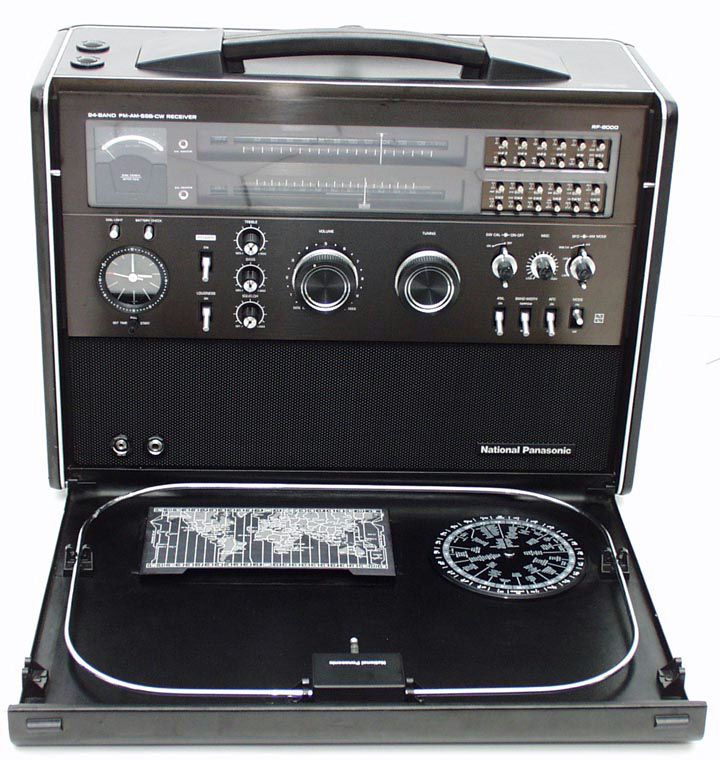
|
RF-8000 Page Copyright ©2001-2003 Ben Blish
No part of this page may be used in any other venue without
explicit permission
from the author and attribution to this web page.
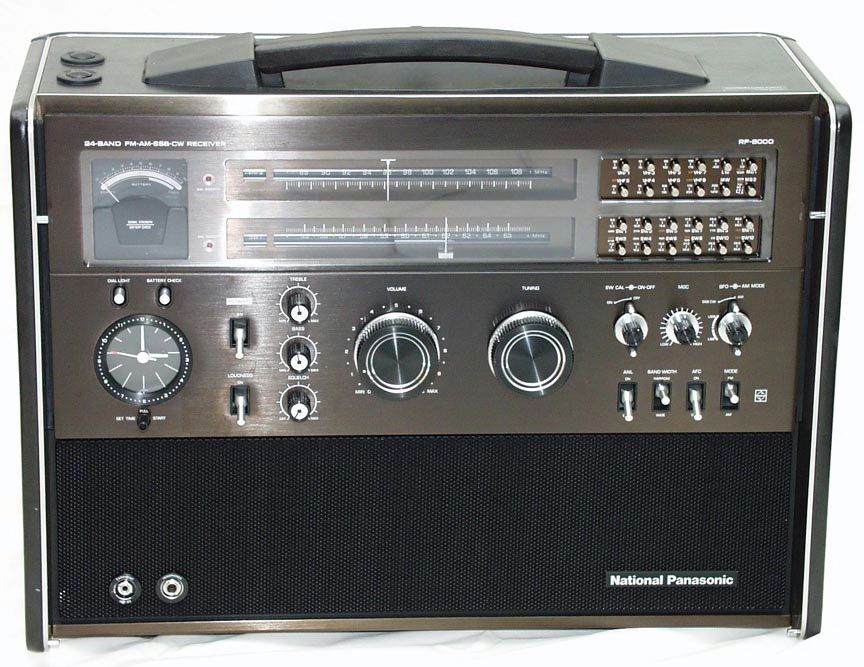
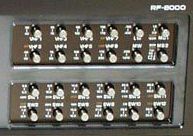 If you look at the image at the right, you will observe a large group of pushbuttons which are located at the top right of the front panel of the radio. These pushbuttons select the band to be listened to. The top group of 12 controls bank one as detailed in the list of bands above. When one of these buttons is pressed, the desired dial scale, one of 12 upon a drum of dial scales behind the top bezel, rotates under control of motors inside the radio until that band is displayed. At the same time, another pair of drums with electrical contacts (over 350 of them!) rotate in the rear of the radio to reconfigure the electronics for the desired band. Sound wild? It is!
If you look at the image at the right, you will observe a large group of pushbuttons which are located at the top right of the front panel of the radio. These pushbuttons select the band to be listened to. The top group of 12 controls bank one as detailed in the list of bands above. When one of these buttons is pressed, the desired dial scale, one of 12 upon a drum of dial scales behind the top bezel, rotates under control of motors inside the radio until that band is displayed. At the same time, another pair of drums with electrical contacts (over 350 of them!) rotate in the rear of the radio to reconfigure the electronics for the desired band. Sound wild? It is!
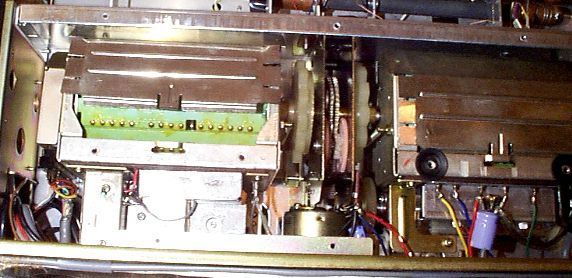

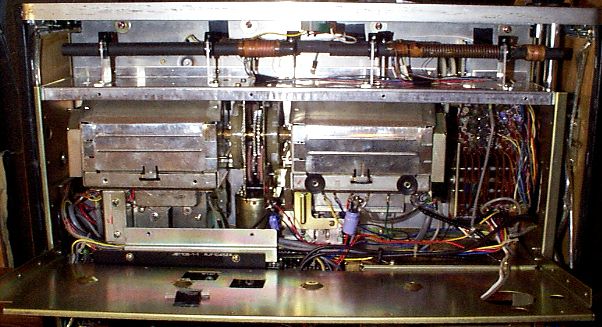
 The procedure to calibrate the radio on a particular band is to turn on the marker, and then turn a knob which actually adjusts the position of the dial scale pointer left and right of center on the lower bezel (the shortwave bands are located here.) In this way, at both ends of a SW band, and at the center, one could ensure that the scale error was zero; this made it very easy to use the dial scale readout as an accurate means to locate a broadcast station. I have many times set the dial to 5.975 or 6.175 MHz before the BBC began broadcasting to the USA, and had the station come on perfectly tuned without any further action required on my part. It's a nice system, one they also used in a less expensive portable, the RF-2200, a very fine radio in its own right.
The procedure to calibrate the radio on a particular band is to turn on the marker, and then turn a knob which actually adjusts the position of the dial scale pointer left and right of center on the lower bezel (the shortwave bands are located here.) In this way, at both ends of a SW band, and at the center, one could ensure that the scale error was zero; this made it very easy to use the dial scale readout as an accurate means to locate a broadcast station. I have many times set the dial to 5.975 or 6.175 MHz before the BBC began broadcasting to the USA, and had the station come on perfectly tuned without any further action required on my part. It's a nice system, one they also used in a less expensive portable, the RF-2200, a very fine radio in its own right.
